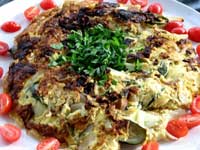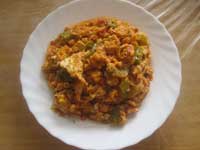
Origin: Murcia

Zarangollo, or Zarangollo Murciano as it is commonly known, is a simple dish which is based on some of the typical vegetables grown in the region of Murcia, such as the courgette (zucchini) and onion. This Spanish dish is therefore most commonly found in the region of Murcia where it is fresh and cooked to perfection, and will probably be harder to find in other regions you might go to when you visit Spain. For this dish alone, Murcia is well worth a diversion to if you decide to travel to Alicante nearby.
Zucchinis or courgettes are a typical example of the vegetables grown in the region and are a favourite amongst Murcian chefs. Not only do they use the humble vegetable in this tasty dish but they also make use of other parts of the plant. When the courgette plant flowers, it produces large orangey-yellow flowers which only last for a few weeks. These flowers occasionally appear in the markets in Murcia and are often stuffed and fried as another great example of Spanish food. However, this is quite rare to find as the flowers are less common and therefore quite expensive.
Zarangollo Murciano is basically a collection of thinly sliced vegetables cooked in scrambled eggs. Potatoes can sometimes be included in the recipe but this is not always the case. The traditional Zarangollo recipe does not have potato, but due to the popularity of the courgette, Murcian chefs have had to bulk up their Zarangollos with the starchy potato. Today, it is quite common to see the dish served with both courgette and potato. The other great thing is that this is a great and tasty recipe perfect for vegetarians and, if you take out the eggs, then it is also suitable for vegans.
In the bars and restaurants in Murcia, Zarangollo can be served hot or just warm and usually found on the menu as either a starter or appetizer with a glass of rich Spanish wine, or as a side dish to accompany a main meal, particularly with fish. It is also often served as a tapa in the tapas bars of the region. In some places, Murcian Zarangollo is even served on its own, cold with a piece of bread as a starter. This Spanish recipe is therefore very versatile and is perfect for any occasion!
This Spanish dish is extremely easy to make but it tastes delicious and is a great way to get some true Spanish culture into your food. Zarangollo is such a typical dish from Murcia that it has not been over-commercialised and exported like some of the more famous Spanish dishes. You can therefore be assured of a true Spanish taste experience if you choose to make this dish!
Ingredients:

Preparation: